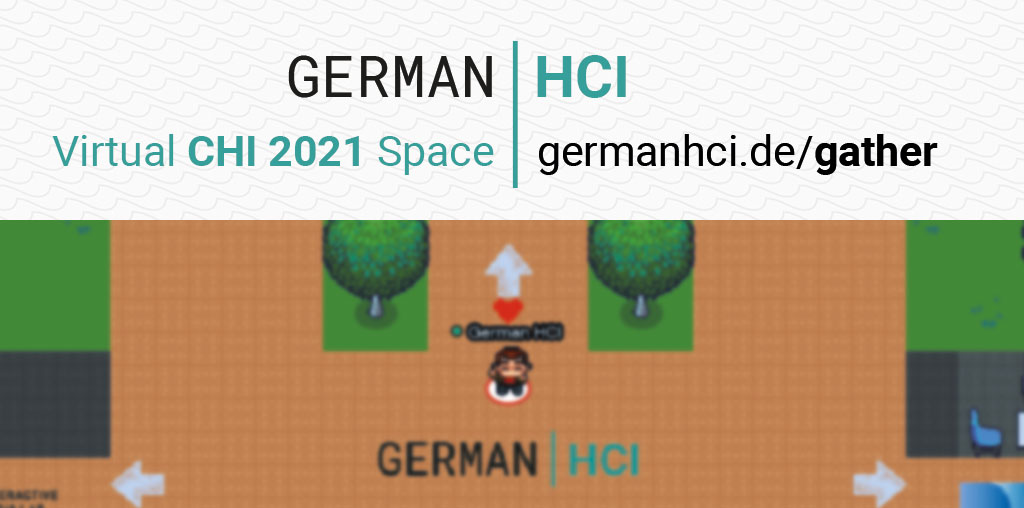What to Expect

During CHI 2021, we will host a virtual German HCI Space on Gather. Within this space, we will exhibit the publications of the contributing labs and provide space to meet and chat.
How to join:
We are hosting the German HCI Space on Gather.
Join here: https://gather.town/app/aKUOyYmD3W8oyfjw/germanHCI
Schedule
Our virtual German HCI space is available during the whole CHI conference – you can simply join at any time! In addition, we host some special events at specific times:
GermanHCI Party
We will be hosting a virtual GermanHCI party on Wednesday, May 12, 8 pm CEST. We have prepared some games and many areas to hangout. So, grab a drink, join us, and let’s have a good time.
Lab Lunches
Our space is open for Lab Lunches throughout the CHI 2021 conference: Monday – Wednesday, 1 pm CEST. You can meet people from our labs and chat about their research.
Using Gather
Gather (https://gather.town) is a web-conferencing tool like Zoom. However, with Gather, you are in a virtual space that allows you to walk around, interact, and talk with other participants that are close to you, just like in real life.
We created spaces for all contributing labs where you can have a look at their publications at CHI 2021 and directly start a conversation with authors and other lab members. Additionally, you can meet your peers in three socializing rooms (there is a bar, a game room, and a coffee shop) or run across a friend in our virtual corridors.
In Gather, you control an avatar using the arrow-keys of your keyboard to move in our virtual space. If you are close to another person (i.e., their avatar), your camera and microphone are activated and you can talk to each other, similarly to other web-conferencing tools like Zoom. Walking away from each other ends this conversation. If you are close to an interactive object (e.g., a video showcase), you can watch it by simply pressing the ‘x’ button on your keyboard – but no worries, Gather will provide you with information on possible actions. In addition, we have listed the most important hints in the following:
- Video chats automatically start with the avatars that are close to you
- In private areas (often marked with carpet), the video chat is activate with all others in this area
- Looking for someone? Click on a person in the participants list and click ‘locate’ to find the right way
- Press ‘x’ to activate interactive objects (e.g., videos, posters, games, …)
- Press ‘g’ to enter ghost mode – then, you can move through other people and are not blocked anymore
- Press ‘Ctrl’+’U’ to activate quite mode – then, video chats are only started when avatars are directly next to you
- And, most importantly: keep ‘z’ pressed to let you avatar dance!
Feel free to have a look at the official Gather 101 to get the most out of your Gather experience.
Contributing Labs
Sorted alphabetically by university name
- Florian Alt, Code Research Center for Cyber Defense, Usable Security and Privacy Group, Bundeswehr University Munich
- Arne Berger, Informatik und Sprachen, Hochschule Anhalt
- Albrecht Schmidt, Human-Centered Ubiquitous Media, LMU München
- Andreas Butz, Mediainformatics Group, LMU München
- Heinrich Hußmann, Mediainformatics Group, LMU München
- Wilko Heuten, OFFIS Institute for IT, Oldenburg
- Jan Borchers, Media Computing Group, RWTH Aachen
- Antonio Krüger, DFKI, Saarland University
- Jürgen Steimle, HCI Lab, Saarland University
- Max Mühlhäuser, Telecooperation Lab, Technische Universität Darmstadt
- Raimund Dachselt, Interactive Media Lab, Technische Universität Dresden
- Michael Prilla, Human-Centered Information Systems, TU Clausthal
- Enrico Rukzio, Institute of Media Informatics, Ulm University
- Rainer Malaka, Digital Media Lab, TZI, Uni Bremen
- Patrick Baudisch, Hasso Plattner Institut, Universität Potsdam
- Volker Wulf, Information Systems and New Media, Universität Siegen
- Volkmar Pipek, Computer Supported Cooperative Work and Social Media, Universität Siegen
- Marc Hassenzahl, Ubiquitous Design, Universität Siegen
- Thomas Ludwig, Cyber-Physical Systems, Universität Siegen
- Claudia Müller, IT for the Ageing Society, Universität Siegen
- Gunnar Stevens, IT-Security and Consumer Computing, Universität Siegen
- Harald Reiterer, HCI Group, University of Konstanz
- Susanne Boll, Institute for Information Technology, University of Oldenburg
- Jens Gerken, Human-Computer Interaction Group, Westfälische Hochschule